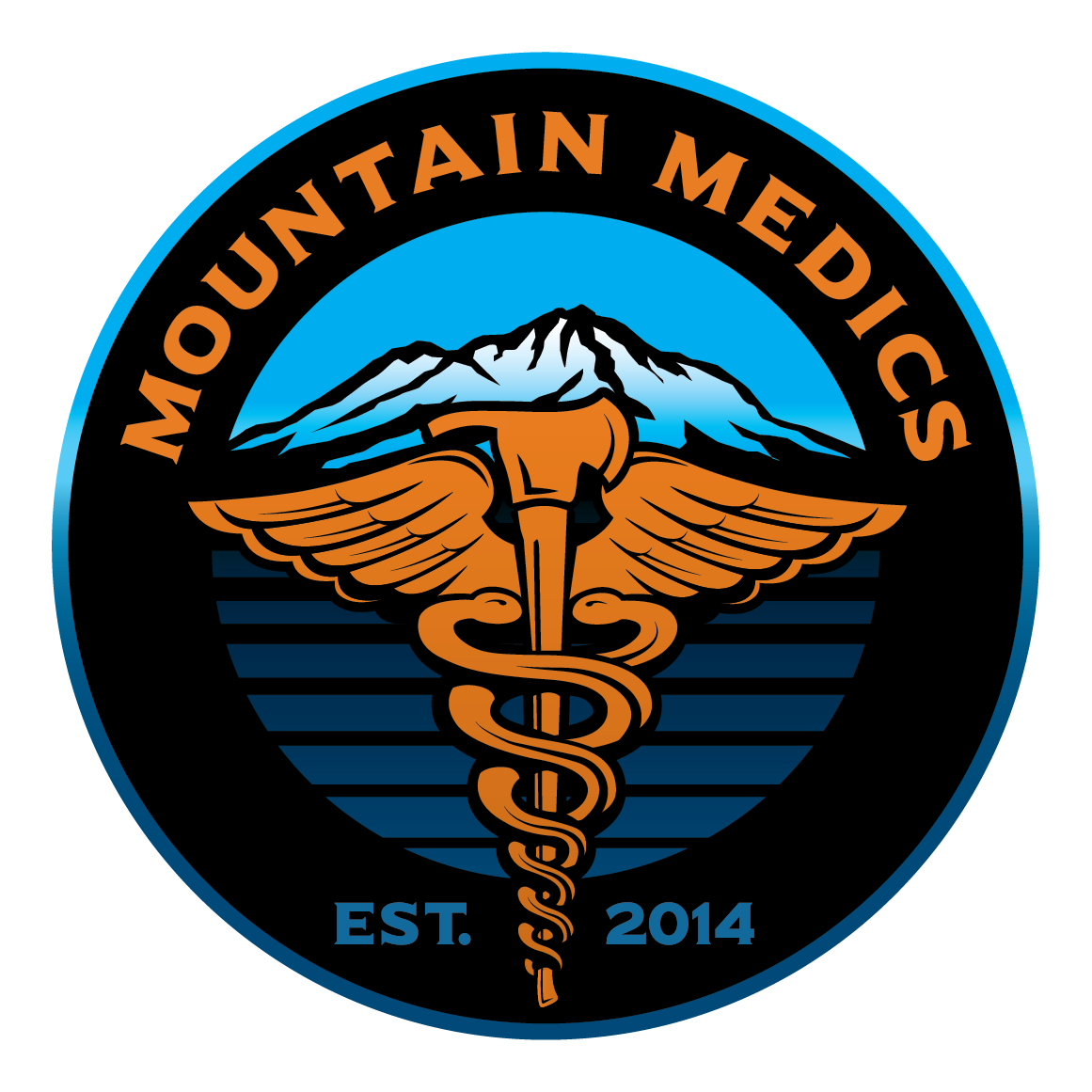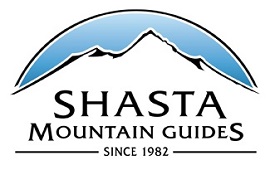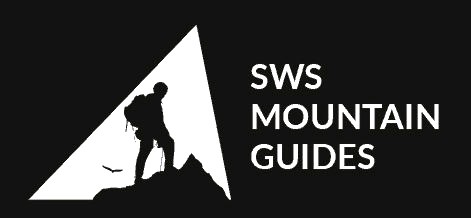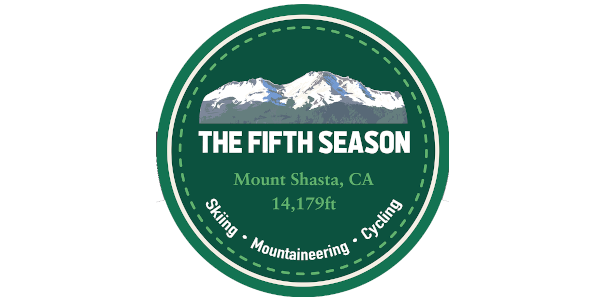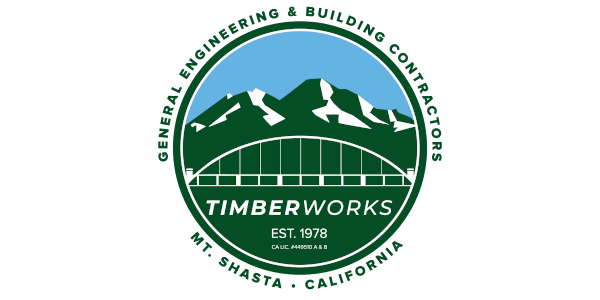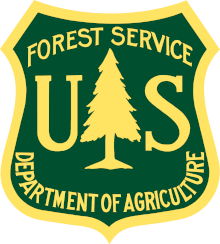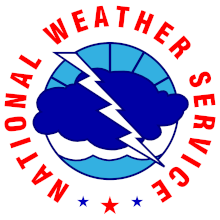Greetings CLIMBERS! Congrats... You have landed at the best place on the internet for Mount Shasta adventure information. We want to help plan safe and enjoyable adventures.
Summertime and the livings easy! That’s right folks, warm and stable weather will remain in play this week with nearly all trailheads on the mountain accessible. As access is granted and the mountain branches out in it's use, please do your part in recreating responsibly by packing out all your trash and leaving the site better then you found it. Have the skills/experience needed for the desired route and tell someone your itinerary. The continued warm temperatures will increase the risk of specific hazards on the mountain:
1. Rockfall. This has been a recent problem that will worsen with warming. As snow begins to melt, rock will continue to dislodge from the upper mountain. Additionally, as you travel on the upper mountain, especially the Redbanks area, be cognizant of the loose rock around you. Anything you kick could hit a climber below. Keep your head up and wear a helmet. To avoid exposure to rockfall, start a couple hours earlier than usual. Get off the upper mountain before 11am.
2.Glaciers. Warm temperatures will increase the melt out rate for Glaciated routes on the East and North Side of Mount Shasta. Crevasse hazard must be considered and mitigated. Glacier travel requires traveling on a rope team rigged and ready for crevasse rescue, carrying a probe for snow bridges, and never glissading on a glacier.
3. Avalanches. Hot temperatures and direct sunlight will increase the chances for wet-loose avalanches. Be mindful when skiing or glisading for moving snow building momentum around you. A boot penetration into mooshy snow that exceeds the boot cuff means the snow is saturated and unstable on steep slopes. This problem will grow in concern as the snow warms. Get an early start to ovoid being in steep terrain by the heat of the day.
4. Heat illness. Heat exhaustion and heat stroke can happen, and they can be exasperated by sun exposure and dehydration. Mount Shasta still has a ton of snow. All the snow, plus direct sunlight and high temps will turn that mountain into a giant solar ven. Expect very warm conditions on the lower/mid mountain. Bring lots of suncreen and sun protection. Drink lots of water. Dont forget your glacier sunglasses!
5. Slips and Falls. This can happen when snow becomes soft, and less supportable. Self-arrest may prove to be difficult in such mushy conditions. Expect punchy, unsupportable snow later in the day. If you plan on climbing a glacier route, consider the effects these temps will have on snow bridges..
Snow is receding quickly down low. This is making for rough and inconsistent travel from trailheads. For skiers, traveling by foot to treeline is recommended before switching to skis. Once on snow, expect heinous sun cups, rain runnels, and extremely tracked out surfaces. These are dangerous ski conditions. Ski conservatively and match your ability to the conditions. Frozen surfaces create the potential for uncontrolled long-sliding falls. These types of falls have proven fatal on Mount Shasta. On the upper mountain please have 12-point crampons, an ice axe, a helmet, and know how to self-arrest.
You have two route options to ascend around the Redbanks. For both routes it is important to give the cliff band a wide berth, staying away from exposed and potentially falling rock.
1. Ascend left of the Heart: This offers decent snow coverage and slightly steeper terrain. This variation can also split up climber traffic on the mountain. Abundant loose rock and ice fall exists above the Redbanks and the Trinity Chutes. Keep a sharp eye uphill when climbing beneath these features to avoid overhead hazards.
2. Ascend right of the Heart: Climb as far lookers-right as possible so to not be underneath the Redbanks and away from rock fall. Aim for the notch between the Redbanks and Thumb Rock. A small step-up to get above the Redbanks requires you to use your hands. Be mindful and move cautiously to not kick rocks down onto climbers below. Climbing the chutes within the Redbanks is not advised.
Snow coverage remains decent on the upper mountain until the Redbanks. Short Hill and Misery Hill are fully melted out, with only rock exposed. We urge climbers to keep an eye on the sky and be extremely cautious and communicate with each other when traversing to Short Hill. Build yourself a margin of safety by climbing early and setting yourself a turnaround time of noon or earlier. Do not climbing into bad weather and have the skills and knowledge needed for the route. Tell someone where you are going and communicate any changes in your plan. Always carry navigation tools and know how to use them.
Weather notes for this week:
The most important weather factor this weekend will be the temperatures. The forecasted temperatures work week are expected to be the warmest we have experienced thus far this season. Winds will still be present at the uppermost elevations causing snow surfaces to remain firm and temperatures to drop from wind chill. If you plan to climb, bring lot of sunscreen, sun protection, DARK SUNGLASSES, and start earlier than normal. Seriously, don't underestimate the warm weather and direct sunlight. Winds are expected to be light and variable, with no precipitation in the forecast. That all being said, Mount Shasta likes to build clouds in the afternoon, so plan on increased cloud coverage as the day goes on.
Let’s talk about some housekeeping things:
Camping at Lake Helen. Remember to pee and/or use your wag bag on the far east side of the Helen Lake moraine. A small privacy pit exists to use your wag bag. Collect snow for water uphill, to the north of camp. Thousands of climbers camp here; so, cleanliness will prevent illness! On another note, wind can often be very strong around camp and the upper mountain. Anchor your tent well. Before heading down the mountain, walk through your camp and collect any micro trash left behind. We greatly appreciate your help in maintaining the natural and cultural integrity of this landscape.
Self-Care. Sun exposure is intense. Snow blindness is a thing. Keep your skin covered and apply sunscreen liberally and often to any exposed skin. Wear DARK sunglasses and a hat. There is no tanning on Shasta, just burning.
Skiing. Skiing from the summit back to Avalanche Gulch isn't feasible this year, due to Misery Hill and Short Hill lacking snow. The best option is to leave your skis at the base of Misery Hill, summit, and then pick your skis up on your way down and choose your best descent line. This time of year, you're likely to find a wide variety of conditions on the mountain. Avalanche Gulch no longer holds ideal ski surfaces.
Human Waste. Do not forget your wag bags. Remember, you are required to pack out your waste. If a Climbing Ranger catches you leaving human waste on the mountain, you will receive a federal citation. Let's leave this place better than we found it.
Be Prepared!!
Our goal is to ensure you have a positive wilderness experience and come home in one piece! So,
- BE PREPARED
- DO YOUR RESEARCH
- ALWAYS WEAR A HELMET
- KNOW HOW TO USE YOUR ICE AXE & CRAMPONS.
- CARRY PROPER NAVIGATION TOOLS AND KNOW HOW TO USE THEM
- REMEMBER, YOU ARE RESPONSIBLE FOR YOUR OWN SAFETY.
Accidents and Hazards
Many incidents occur on the mountain every season. The most common accidents include rockfall injuries, lost climbers, and slips and falls in steep terrain. Most accidents can be prevented with proper planning and preparation.
- Do not climb into a whiteout. Always carry a map and compass and/or GPS device and route plan ahead of time.
- Keep your group together. If you split up, have a solid plan and make sure everyone has proper equipment and knows the way.
- Do not glissade with crampons on. If you choose to glissade, take OFF your crampons and make sure the snow is soft.
- Know how to properly self-arrest with your ice axe. A slip and fall on the upper mountain can be fatal.
- Wear a helmet and watch out for rockfall. Climbers get hit every year.
With the right knowledge, skill, equipment, and decision-making, all of these accidents can be easily prevented. Please, wear a helmet, and know how to use your ice axe and crampons any time of the year.
There is always the potential for thunderstorm activity during the summer months to shroud the mountain in clouds, limiting visibility. Climbers becoming disoriented on the upper mountain in whiteout conditions and subsequently descending the wrong route is not uncommon. These kinds of scenarios have resulted in many searches over the years. It should go without saying, but we will say it as a solid reminder: Check the weather before you go and more importantly, monitor the weather as you climb. DO NOT CLIMB INTO A WHITEOUT! Being caught on the mountain in any type of weather can compromise life and limb.
Understand that if something goes wrong or a member of your climbing party gets injured, you need to be prepared to self-rescue. If you have an emergency on the mountain, call 911. Be prepared to provide your location and the nature of the injury.
Many hazards exist in mountain terrain. Some of these include:
- Ice and rockfall
- Altitude
- Extreme weather
- Avalanches
Icefall and rockfall are possible year-round. It's a simple equation: as snow melts, rockfall increases. If rime ice is seen plastered to exposed rocks above, it will eventually flake off and fall onto climbers. Wear a helmet and keep your eyes upslope as you climb. Pay attention to other climbers: rockfall is often caused by climbers resting in melted out areas and accidentally dislodging rocks onto slopes and climbers below. Be careful not to kick rocks down onto others.
At the height of 14,179 feet, Mount Shasta is a high altitude peak. It is common for climbers to experience acute mountain sickness (AMS) with signs and symptoms of nausea, headache, and lightheadedness. Despite being a common condition, AMS should not be taken lightly. It can quickly develop into a much more serious and potentially deadly pulmonary or cerebral edema. Rest and hydration are vital to alleviating AMS symptoms. If these symptoms do not improve, your only choice is to descend!
Mt Shasta is a 14, 179-foot volcano with steep slopes, avalanches, glaciers, rockfall, altitude, and extreme weather. Some may feel like Mt Shasta is "safe" due to its proximity to Interstate 5 and its "easy" climbing objective connotation. This is false. One should still expect cold, winter-like conditions at any time of year. Have the appropriate gear AND skill level. Mountaineering is dangerous, and climbers must constantly evaluate the terrain, weather, and many other factors to have a safe trip. One should also not expect immediate rescue. Many factors can prolong rescues. Thus, it is necessary, no matter what mountain of the world, that you be prepared.
Mountain Weather
Check the WEATHER FORECAST before coming up onto Mt. Shasta! Our site's main menu hosts numerous resources on the weather. Researching the mountain weather should be an important part of your trip planning.
Clouds and Precipitation: While you may encounter fair weather at lower elevations, cloud caps can form up high. Never climb into a whiteout, as many climbers have become lost or died in similar conditions. Many routes from all aspects of Mt. Shasta converge on the upper mountain (>12,500 feet). During limited visibility conditions, climbers have descended the wrong side of the mountain. Keep an eye on the sky as you climb, turning around if clouds begin to build on or near the mountain.
Lightning: Mt. Shasta is a 14,000-foot lightning rod and is frequently hit by lightning (usually in summer and fall months), so don't push your luck with building thunderheads.
Wind: Winds can reach over 100 mph at tree line (8,000 ft) and much higher in the alpine region. Winds of 40 mph can knock you off balance. Winds of 60-70 mph can force you to crawl. Hurricane strength winds (>74 mph) can make it nearly impossible to stand and will destroy well-anchored tents. The strongest winds occur with big pressure and temperature gradients in the atmosphere and tend to occur in front of and behind storms. The lowest winds occur when the center of high pressure is over the Mt Shasta area. Take this seriously as the wind has resulted in searches, injuries, and fatalities.
Tips & Notes
Climb early and descend early. This limits exposure to inclement weather (afternoon buildup of clouds is common), allows plenty of time to descend before dark and allows a rescue effort to ensue before dark if one gets injured or lost.
Get an alpine start (2-5 am) and have a turnaround time of 12 to 1 pm. Proper equipment, clothing, and training are a must. Helmets are always recommended and expect rock and ice to fall at all times.
Bring extra warm gear (like a down jacket, balaclava, and extra gloves) in all seasons as climbers often develop superficial frostbite during strong winds. The wind chill temperature near the summit in winter and spring can be well below zero.
Anchor your tent well wherever you camp. Tents can and do blow away frequently. Do not plan to camp above treeline if you do not have anchor lines for your tent.
Solo climbing is not recommended. Traveling with an experienced group is a good idea, and remember - do not split up the group!
The routes on the north and east sides are not recommended for unguided novices; glacier travel and route finding skills are prerequisites.
Mountain Rescue
Do not expect to be rescued. Rather, prevent rescues from happening in the first place, and be prepared to handle rescues within your climbing party should something happen. Nature sets its own terms, and YOU must judge how much risk you are willing to accept.
When to Climb
The BEST time to climb Mt. Shasta is usually from May to mid-July on the south and west sides of the mountain when summer days are longer and the weather is generally stable. However, in dry years, the thin snowpack creates the best climbing conditions in April, May and early June. When the snow melts, you are left with 7,000 feet of scree, talus, and boulders. In heavy snow years, the climbing season extends to August or September. There is NO trail to the summit. Climbing is much safer and more fun on consolidated snow.
A winter climb of Mt. Shasta is possible. Still, it is more difficult and dangerous: extreme weather, short days, avalanches, falling ice and potential post-holing increase the difficulty and danger on all routes. If you choose to travel in the backcountry during the winter and spring, you need to have the proper equipment and training to stay safe. An avalanche beacon, shovel, and probe and the ability to identify avalanche terrain and snow stability are essential. A climb of Shasta should not be taken lightly.
Every year, many climbers become lost, injured or killed while attempting Mt. Shasta. Many of these accidents could have been prevented with a little bit of pre-planning and training. YOU need to come prepared.
What to Bring
- MANDATORY: wilderness permit, summit pass, human waste pack-out bags. Available for self-issue at all open trailheads.
- THE TEN ESSENTIALS: map and compass, sunglasses and sunscreen, extra food and water, extra clothing, headlamp/flashlight, first aid kit, matches/lighter, stove, knife/multi-tool, bivy sack
- HELMET, ICE-AXE, & CRAMPONS
- AVALANCHE BEACON, AVALANCHE PROBE, SHOVEL
Wilderness permits, summit passes, and pack-out bags are currently available at all trailheads, the Mt. Shasta and McCloud Ranger Stations and The Fifth Season outdoor store in Mount Shasta City. All trailheads are currently open. Annual passes ($30) are available at The Fifth Season store as well as the Mount Shasta/McCloud Ranger Stations. The Mount Shasta and McCloud Ranger Stations are usually open Monday through Friday from 8 to 4:30 PM. Check our climbing regulations for more details.
Using common sense and carrying the TEN essentials keep you and your party out of search and rescue statistics. Wear a helmet, and know how to use your ice axe and crampons. Be prepared and pay attention. The mountain has extreme weather changes.
Winter and Spring months usually see periods of heightened avalanche danger, though this danger could exist in the summer months under the right circumstances. Research the weather and avalanche danger while planning your trip. Have your climbing party bring avalanche beacons, probes, and shovels armed with proficient skills in their use. Know how to identify avalanche terrain and evaluate snowpack stability.
Shasta Alpine Hut
The stone cabin at treeline on the Avalanche Gulch climbing route is open year-round and all are welcome. However, one cannot sleep inside the cabin, except in emergencies. The composting toilet is open for the season and drinking water is available at the spring. Caretakers are present five days a week for the climbing/hiking season. If you plan on camping, there are two dozen dispersed sites on the property, a nominal $3/bivy and $5/tent fee is asked. There is a fee deposit tube inside the cabin. This fragile area gets a lot of use. Please practice Leave-No-Trace principles. Lastly, the property owner, the Sierra Club Foundation, manages its property under the Mt. Shasta Wilderness rules – dogs, horses, and other domestic animals are not allowed. No drones. Thanks!
Dogs
DOGS, AND OTHER DOMESTIC ANIMALS, ARE NOT ALLOWED IN THE MT. SHASTA WILDERNESS OR WITHIN THE SIERRA CLUB FOUNDATION PROPERTY BOUNDARIES (Shasta Alpine Hut).
Recreate responsibly, my friends. This means to plan and prepare properly. Be honest with your own and your group's skills and abilities. Be kind to others. Respect the mountains and Mother Nature. Pick up after yourself. Leave-No-Trace. Don't love to death the places that we love.
Please read all the information below to learn about current conditions, how to climb Mount Shasta, wilderness and climbing regulations, and mountain safety tips. Despite being 15 minutes off I-5, climbers should understand rescue is neither automatic nor instant. Even rescues that seem easy and straightforward involve planning, effort and risk.
If traveling above 10,000' you need to purchase a summit pass, even if you don't plan to summit. These are available for self-issue at all open trailheads and the Mt. Shasta or McCloud ranger stations. Annual summit passes are available to purchase at The Fifth Season gear shop in Mt Shasta City during business hours. Bunny Flat and North Gate are currently the only maintained and vehicle accessible trailheads.
Climber safety and mountain sanitation are two of our top management priorities. Please do your part to keep the mountain clean and pack out all waste. It is REQUIRED to pack out your human waste on Mt. Shasta. Yep, if rangers catch you pooping without a wag bag, a citation can be issued. FREE wag bags are available at all open trailheads.
Please help keep Bunny Flat clean. It is one of the busiest places on the Forest. Camping is allowed in the parking lot or just below in the dispersed camping area. It is primitive camping, no water/other services available, except bathrooms. The camping stay limit is 7 consecutive days, and no more than 30 days total in the calendar year. Pack out your trash.
Check our recent observations for photos and read the spring avalanche statement for the most up-to-date mountain conditions.
Southside conditions are rapidly dwindling with variable surfaces and suncupping in Avalanche Gulch. Downhill travel on skis has been difficult. Ridge routes in this area are melted out to rock.
Routes on the north and east side of the mountain hold more snow and better conditions. Travel on the Wintun, Bolam, and Hotlum glaciers should be done with caution as they are changing on a daily basis. Accessing these routes brings the need to plan for a longer approach due to snow on roads.
Brewer and Clear Creek trailheads are only accesible by foot with the ability to drive a vehicle within a few miles of the trailheads. These trailheads are currently not being maintained so plan to get your wilderness permit, summit pass, and human waste packout bags from our other facilities. Use our weather tab to access the best forecasts. Leave a travel plan with your loved ones and don't ignore what the mountains are telling you. Mount Shasta isn't going anywhere anytime soon and you can always return during safer conditions.
Our weather tab has several great links for weather, including the rec forecast and discussion.
Please join us June 30th at 6 pm for a speaker series “So, you want to climb Mt Shasta…?” at LOGE Mt Shasta for a one-hour digital presentation on what it takes to climb the mountain. Admission is free!
Please read all the information below to educate yourself on general information about what it takes to safely climb Mt Shasta. If you have further questions, don't hesitate to give us a call. We are not always in the office, but will respond as soon as we can: 530-926-9614 or email nicklaus.meyers@usda.gov.











